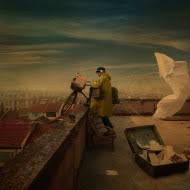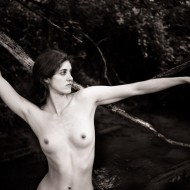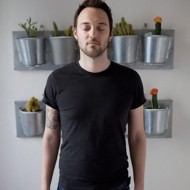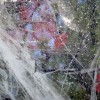Charlie Simokaitis is the first photographer who responded to my call to deepen the discourse about photography, writing a long and detailed article about his portfolio Fade to White.
A wonderful series -triggered by his personal situation- of large format camera photographs about blind people and their lives. Narrative photographs with a little bit of irony, but also with great empathy and respect for the portrayed subjects. And above all very touching human situations, people, lives. Thanks Charlie for telling us all those stories behind the pictures, I think this really adds an extra dimension to your beautiful photos.
Following text and photos by Charlie Simokaitis.
Fade to White
I live among vague, luminous shapes that are not darkness yet.
Borges, “In Praise of Darkness”
I have always been drawn to fiction for which I credit the Jesuit that placed a copy of Camus’ The Plague into my hands at the age of 14. Additionally, having seen many productions of the works of Samuel Becket, most notably Happy Days, The Theatre of the Absurd also has a particular resonance for me. Hence, when I embarked upon this recent project entitled Fade to White, in which I photograph blind subjects, I endeavored to incorporate a fictional element into what has most often been a subject for the documentarian or the “neutralist.” I wanted to respond to these traditions by telling a story within a story, while clearly maintaining empathy and respect towards my subjects. Advancing the dialogue in this way, it is my desire to uniquely honor my models by collaborating with them.
Photographs of the blind are most often aligned with street photography, however, for this project I wanted conversation to play a central role in the creation of these images by discussing the ways in which one expects blind people to be depicted in photographs. Additionally, I wanted to reference the effects of vision loss, making the act of seeing/looking more deliberate by working with a large format camera, and lenses, that by modern standards, are compromised. In attempting to articulate how the models appeared through the ground glass, I was deeply humbled as some of my subjects were born blind, making my description irrelevant. The use of the view camera references photography’s past and the many examples of how blind people were photographed historically as well as tableaux photographs, which were the fashion during the mediums earlier years. Thus, I have fictionalized or modified many of the scenes, questioning, perhaps irreverently, the expectations of what a photograph of a blind person should be and have framed this work as a shape-shifting, narrative portraiture.
Having seen pictures of the blind created by photographers like Strand, Arbus, Winograd and DiCorcia, I wanted to address the fetishism of other people’s perceived pain and the taboos and tacit responsibility of representing a blind person. Arbus was drawn to photograph the blind “because they can’t fake their expressions. They don’t know what their expressions are, so there is no mask.”
As my daughter Faye will soon be blind herself, I wanted to become acquainted with people that live with this condition. I accomplished this by writing a statement and circulating it via a contact at The Chicago Lighthouse for the Blind and later, The Oklahoma League for the Blind.
Ultimately, having read this, all of my models approached me with an interest in being photographed. At this point I am continuing to make my way through a long list of interested blind people and have begun to photograph many of my models a second time.
In this image from Oklahoma City, I brought my subject Donald Hansen from his actual work environment, in this case an office, and situated him in this fabricated one, a power plant. Thus, I have engaged a blind actor to star in a photograph of an imaginary other; a guy named Gary that works in a power plant and is on his way to lunch. In this inverted subterfuge the ruse plays into the hands of the blind person, as the viewer has already made assumptions based on the subject’s blindness. By playfully exploiting the subject, his blindness clearly imbuing his persona by virtue of the telltale white cane, I have endeavored to make more visible a blind man, to create an icon of sorts. This is Oklahoma City in June – in a power plant. It was probably 100 degrees and very loud. As Don could not see or hear me I kept running into the shot to direct him. A man of few words, Don found the process very amusing.
In James Kelman’s book, How Late it Was, How Late, the suddenly and mysteriously blinded protagonist makes his own cane out of necessity by cutting down an old mop handle with a saw. He does this so that other people will know why he gropes and staggers around as he makes his way down the streets of urban Glasgow, Scotland. Shown here is Mary Abramson with a 12’ long cane, which I made from a dowel rod. Mary is a cane advocate and educator, a staunch believer in independent living for the blind. As so many other members of the National Federation for the Blind, Mary uses the longer style cane, which can often be as tall as the user. Obviously, the cane in this photo is absurdly long. When I discussed the shot with Mary she was pleased with the irreverent tone of the image. One thing to point out is that NFB members are fervently engaged in the politics of blindness as evidenced by a recent successful litigation against AOL, whose online service was deemed exceedingly difficult to use for people with vision issues. Additionally, the NFB has made several statements about the negative depiction of blind people in Hollywood films. Predictably, the release of last years film Blindness, based on the Nobel Prize winning book by Jose Saramago was lambasted upon its release by the NFB. With this said, it was with a certain knowingness of the pitfalls of what is or is not politically correct among the “enlightened” blind, that we captured this image.
Steven Herrera was 25 when he was unwittingly transformed from a typical young college graduate with a new job, house and car to a blind man – overnight. Doctors are still perplexed over his case as both of Steve’s retinas detached while he was sleeping, rendering him 99% sightless. Ultimately, Steven moved back in with his mother where he has lived for the past 10 years. After Steve was stricken with his blindness he spent months in bed, afraid to venture out of his bedroom and also refusing to believe that his vision would not miraculously reappear as suddenly as it had disappeared. His account of waking up that first morning to the sound of the alarm clock and trying to look around the dark space that was once his bedroom is truly horrifying. Later, after he had moved in with his mother she would leave not only breakfast but also lunch on his nightstand before she would go off to work for the day. A week before I had arrived in Oklahoma for this shoot, a man had pulled his car up to where Steve was waiting for the bus and offered him a job. In this image Steven’s mother references the Mother, looking out into the back yard to ensure that the children playing out there are content and safe. Caught in the reflection of the glass back door, Steven is literally and figuratively, the child in the yard.
Timothy Paul plays blind baseball, in which all participants are blindfolded (to “level the field” as it were, as many blind people can see shapes, shadows, etc) as a noise-making ball is pitched toward them. If the batter successfully hits the ball, one of two beeping bases will signal the runner which way to run. The fascinating part is that as a runner you are running at full speed into the darkness. As Harmony Korine’s film Gummo successfully blends real life characters and realities with elements borne of artistic intervention I too have found my comfort in the ambiguous space somewhere between reality and fiction. With this said, I look at this project holistically, each image is like a scene from a film. Elements or characters that, at first, appear incongruous will become motifs as the movie plays on.
This past year I saw Becket Fragments, directed by Peter Brook, whose stark lighting and design, not to mention unique strand of emotionality and humor are referenced in several of my blind portraits. When I first met Robert Thompson, he greeted me in the lobby of his building and before we said anything to each other he handed me a pair of paper glasses, which have a tiny 5-degree hole in them. These glasses were created to replicate the effects of Retinitis Pigmentosa, which most often results in the narrowing of the visual field from the periphery. We then headed out for a walk in a bustling urban neighborhood with Robert guiding me. Much laughter ensued.
Robert has Usher’s Syndrome, which resulted in his being both legally deaf and blind. He is a lover of music and feels it with a hand on a speaker or radio much like the people featured in Werner Herzog’s documentary The Land of Silence and Darkness.
This photograph (first above) was taken in the light well of my building – in the bottom of a shaft in the center of our building where natural light can get into the interior rooms of the apartments above. Because his syndrome affects his balance, Robert has a distinctive gait, which has resulted in his being stopped by police on several occasions for suspected public intoxication. We had to exercise caution as we made our way through the myriad of pipes and ducts in my basement. He loved the location (Robert can see a little) and felt it aptly represented his life.
Additionally, Robert is also blind in the center of his retina so he hasn’t seen his own face in 20 years. When I made the two photographs in his bathroom, Robert was still recovering from a near fatal bite from a Brown Recluse spider, which had bitten him on the face while he slept, resulting in a stint in the hospital. When we made the images in the diptych he was laughing as he said, “I usually shave in the dark!”
I photographed Amy Bosko before a storm on the banks of a canal that runs behind the house she shares with her mother and brother. I saw in Amy a surrogate for my own daughter. She is the same age as Faye, though her blindness is far more advanced. This was during the earliest stages of the project and I wasn’t yet prepared to photograph my own child in its context. I also wanted the opportunity to see what life is like for a blind child before I did so. In the many discussions that I had with Amy before the shoot I was struck by her desire to be in the limelight, the center of attention. Like so many kids, her one ambition in life was to “be famous.” I learned in subsequent conversations about the travails of being a blind girl in a classroom full of sighted children, and the social challenges this presents in terms of developing friendships. For me this image represents the loneliness that can often accompany an unsighted child in a sighted world. This is the dress that Amy had worn at her recent birthday party, which celebrated her 9th year.
This diptych is comprised of Jackie Anderson and Coby Livingstone, two blind sisters. Jackie lives in Chicago and Coby I shot while in Oklahoma City. There is a third sister, Wendy that I am planning to shoot in the coming months. There are references to vision here in the reverse/negative use of the background and clothing. These backgrounds always remind me of old circus curtains or canvases, and allude to the otherness of circus performers and sideshow freaks and their exploited abnormalities. The presence of the mouse pokes fun at the notion of these sisters doubling as animal handlers or oddities while also citing the nursery rhyme Three Blind Mice.
This was Thanksgiving Day in Milford, Ohio. Henry, (Right) my nephew, was amusing adults and children alike with his dance repertoire minutes before this was taken. When photographer Robert Lyons was critiquing my work last summer he asked me why I had not yet photographed my daughter as the impetus for the project lies with her. As evidenced by her expression, one could surmise her attitude. However, the story with Faye is more complex, as she is on the autistic spectrum and is also exceptionally defiant, especially when she feels like she’s being looked at. Not surprisingly, there were never any dolls in her bedroom as they would be quickly ejected for staring.
Jennifer Justice, who I have shot previously in the guise of St. Lucy, the patron saint of the blind, is standing in the snow with her boyfriend Kevin who is also blind. Jennifer comes from Tuscumbia, Alabama, home of Hellen Keller, where she was once selected to be the Grand Marshall in the annual Helen Keller parade. My intent was to create a companion of sorts to the diptych of Robert shaving, with its warm welcoming light, a man in a t-shirt shaves in the confined space of a bathroom. This image provides a counterpoint with its cooler palette; the models here are dressed, somewhat formally, for the cold, in a wide-open space. As I spent most of this bleak winter day hanging out with Jennifer and Kevin in the apartment that they share, I was struck with a profound sense of optimism borne of the feelings that this young couple shared for each other.
The people that I have photographed for this project have been extremely generous with their time and their willingness to open up their homes and lives to me. The universal and genuine enthusiasm for the project testifies to the desire for these blind people to become more visible to us. Ultimately, as I spend more time with blind people I am developing a perverse kinship with the very condition that will eventually lay claim to my daughter’s eyesight.



































Hi Charlie
thank you very much for your article. I really loved the text you wrote, it is exactly what I was waiting for. And I’m really tuched by the story you are telling. I think photography can stand alone, but at the same time I’ll never look at the picture you describe in the same way. Now they are not only photographs, but real lives.
Thank you, really.
Congratulations. Great project. I hope to see more of your work.
Congratulations! This is very stirring work, and I’m so glad it’s being SEEN.
I am a friend of Robert Thompson who has lost touch with him over the years. I see you photographed and wrote an article about him. Is there any way possible that you could provide me with his contact information? (email, phone).
I would be ever so grateful.
Thank you!!!
You can also subscribe to this post comments RSS feed.